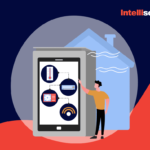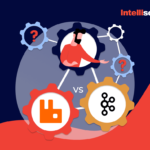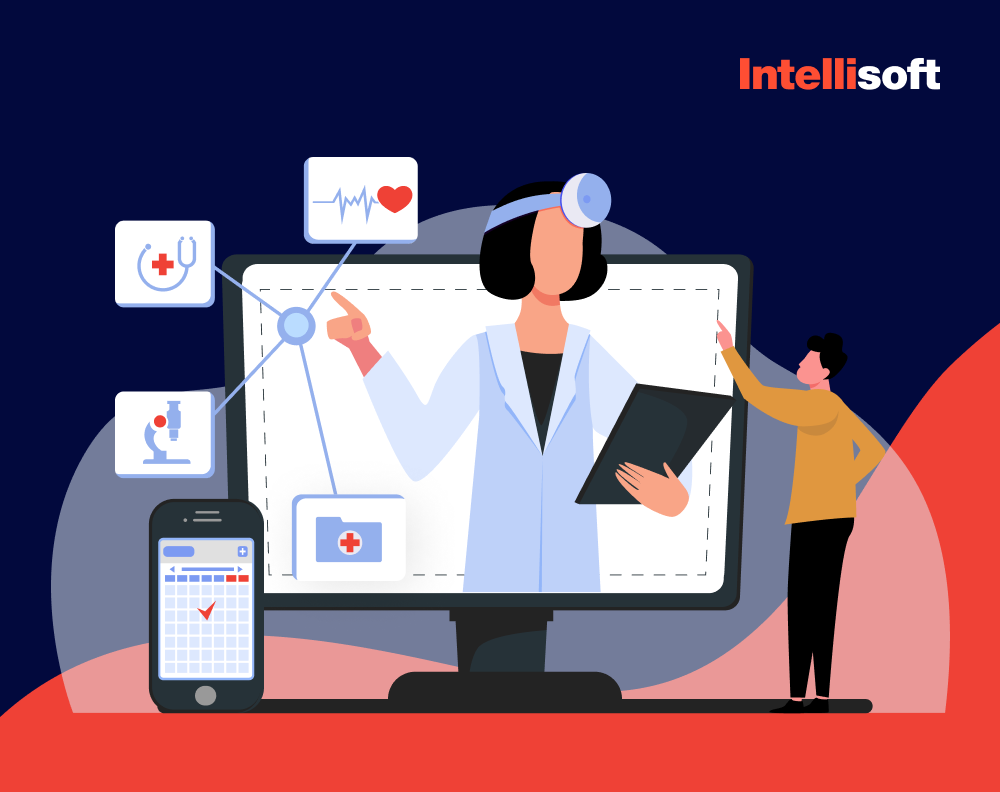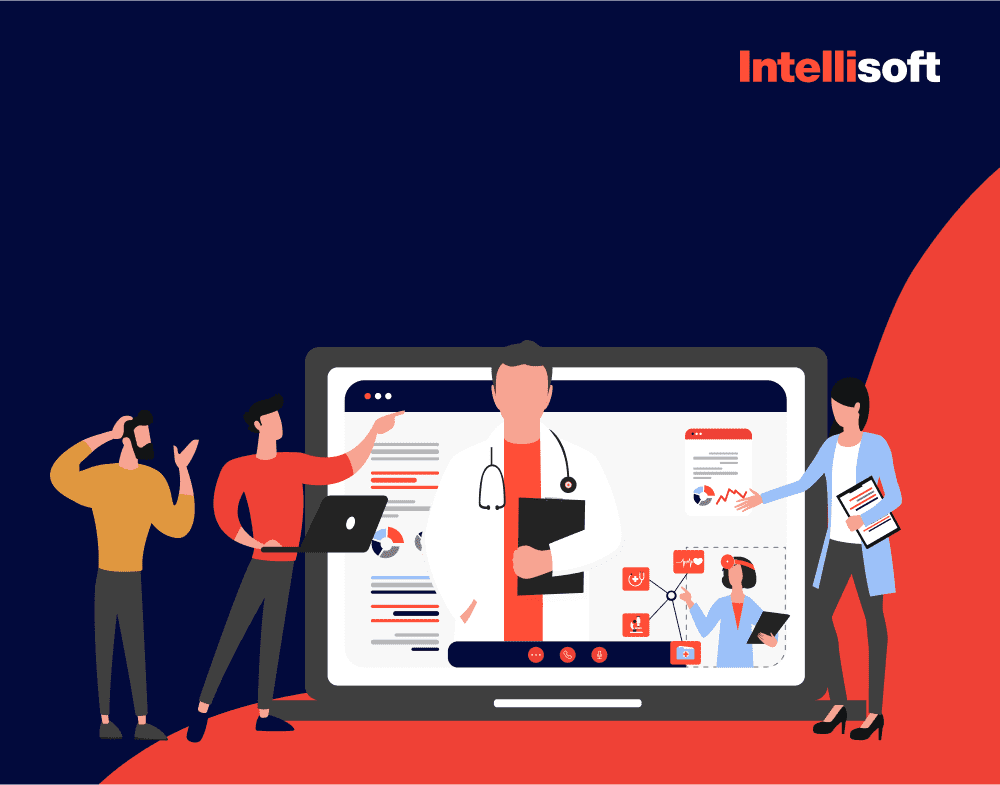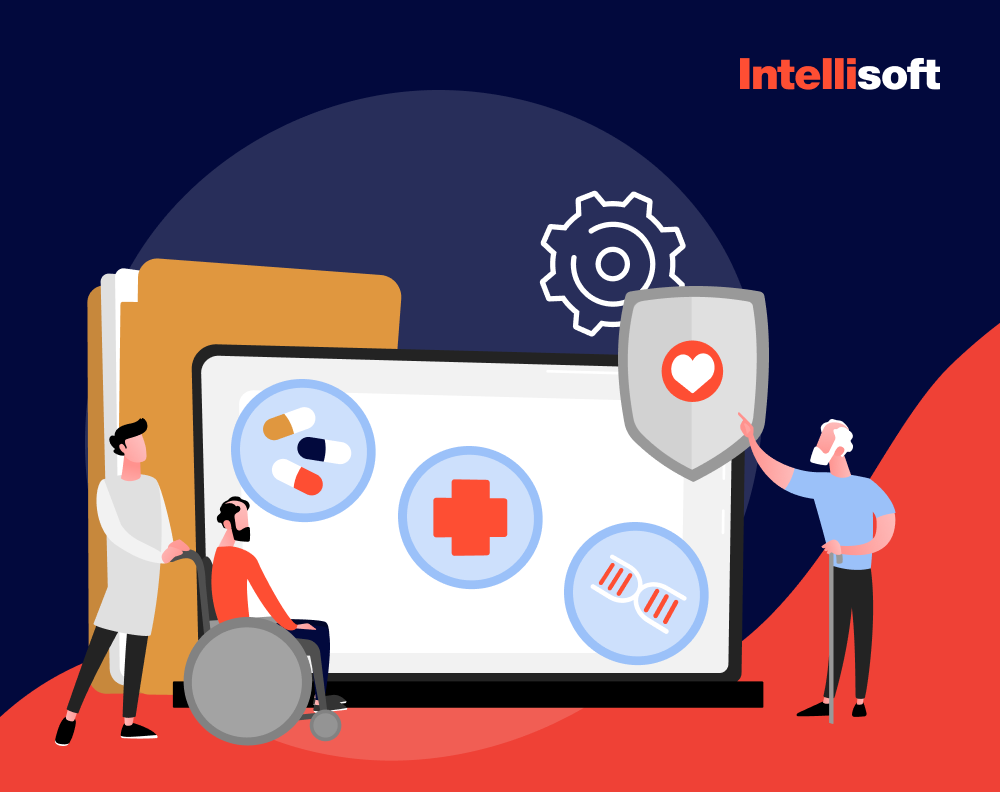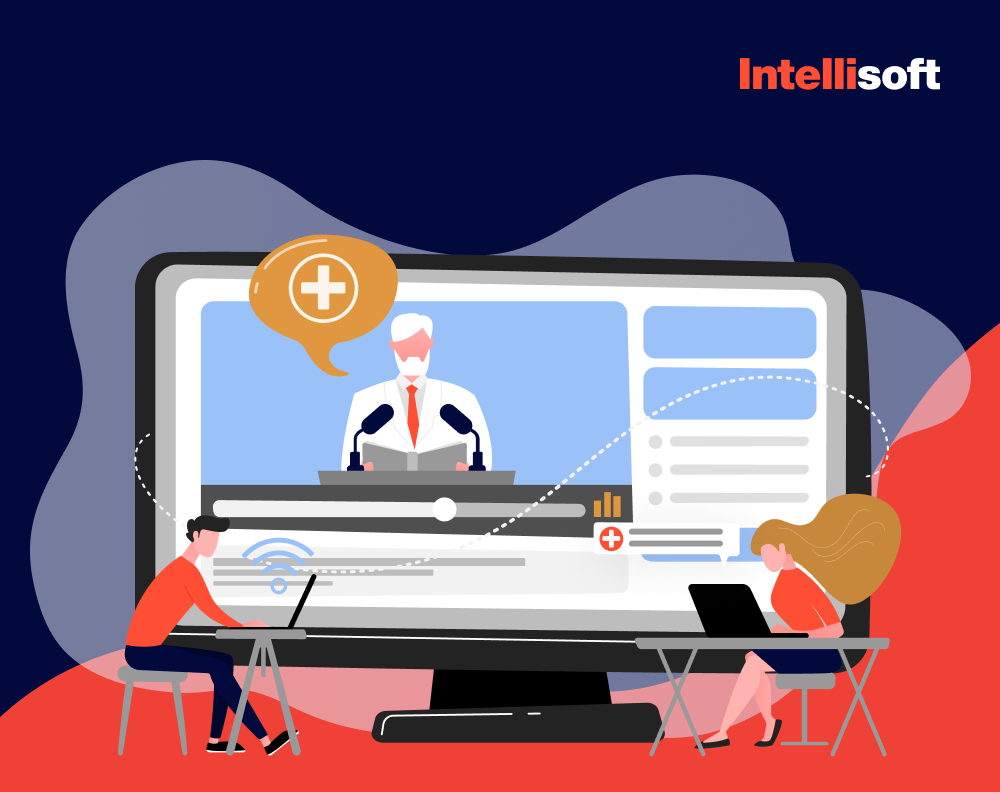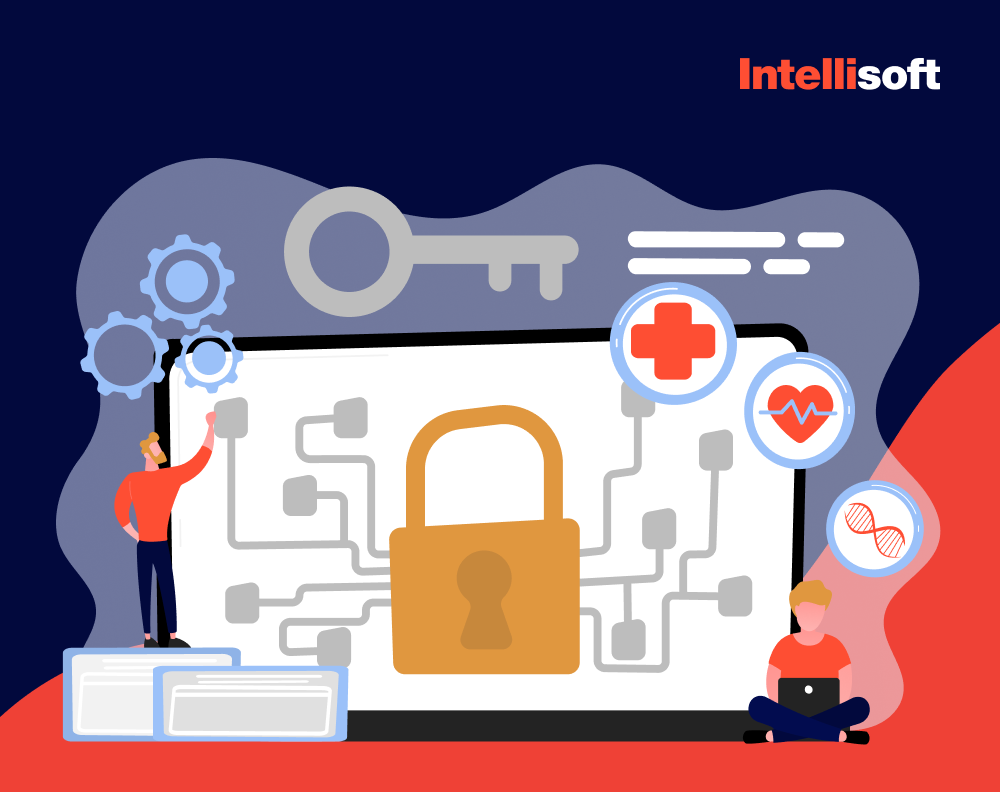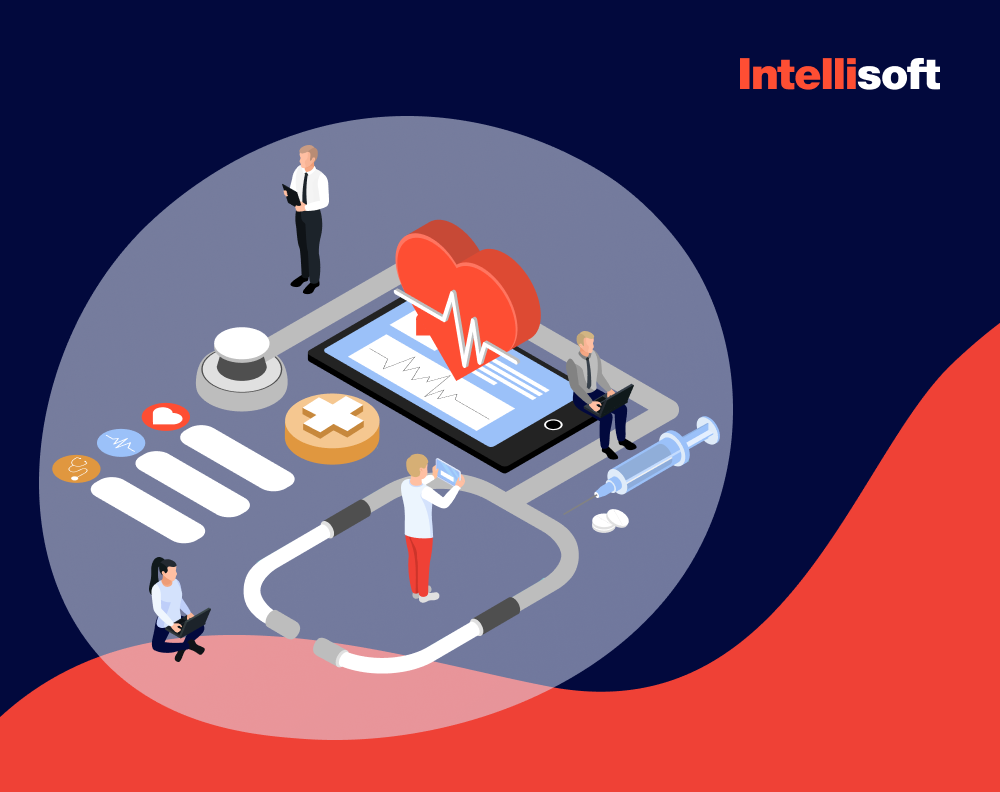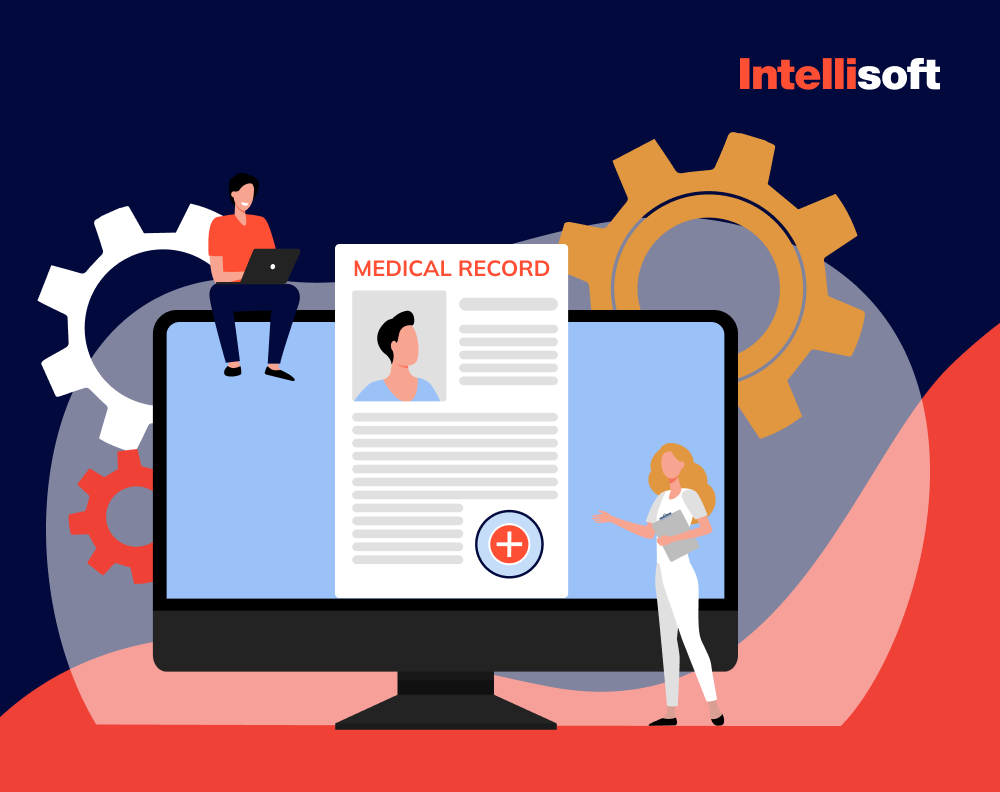As per the latest report by GlobeNewswire, the clinical decision support software market is currently valued at a whopping $2.1 billion, and it is anticipated to reach $3.8 billion by 2030. This data signifies that healthcare providers increasingly recognize the CDSS’s potential to offer top-notch services, making it a real ‘Infinity Gauntlet’ in the medical world. But what does this system mean in essence? Let’s explore this topic and find out what CDSS is, which option healthcare professionals prefer, custom or an existing one, and how to develop such a system.
As a company with over 15 years of experience in healthcare software development, IntelliSoft know all the details of how to develop CDSS and can suggest a relevant tech stack.
Table of Contents
What is the Clinical Decision Support System (CDSS)?
What is clinical decision support software? Clinical decision support software (CDSS) is a computer application that helps clinicians make sound decisions about patient care. It combines vast medical knowledge with a patient’s health information to offer guidance, alerts, and critical data that support the provider’s decision-making process. The goal of clinical decision software is to improve healthcare delivery by supplying caregivers with evidence-based data, guidelines, and insights at the point of care.
CDSS analyzes patient information such as medical history, laboratory test results, and diagnostic imaging and compares it against a vast knowledge base of medical literature, clinical guidelines, and best practices. It also considers patient demographics, social determinants of health, and other factors that could affect patient outcomes. By analyzing this vast amount of information, this decision-making tool equips caregivers with comprehensive patient care support and enables them to make more sound decisions.
The guidance provided by CDSS can range from drug interaction alerts to more complex healthcare decision tools that help healthcare professionals develop the most effective treatment strategies for specific patient conditions.
What are the categories of CDSS?
Knowledge-based CDSS
A Knowledge-based Clinical Decision Support System (CDSS) is built upon a comprehensive knowledge base, which is a structured collection of data presented in the form of if-then rules. These rules are designed to analyze the data and generate specific actions or recommendations. The creation of these if-then statements is based on evidence obtained from clinical practice, scholarly research, or direct patient information. This system incorporates expert medical insights to offer recommendations on diagnoses, treatment options, and prescriptions, drawing from the input data. Therefore, the effectiveness of a knowledge-based CDSS depends on its foundation of structured and authoritative medical knowledge.
Non-knowledge-based CDSS
Non-knowledge-based Clinical Decision Support Systems (CDSS) make use of data sources but rely on artificial intelligence (AI), machine learning (ML), or statistical pattern recognition for decision-making. These systems are capable of identifying patterns within large datasets and deriving decisions from them. This approach is particularly useful in situations where the data volume is extensive, the knowledge base lacks clear structure, or explicit expert medical knowledge is unavailable for a specific issue.

CDSS consists of three main components:
- Base. Specialized clinical decision support tools for patient care can be either knowledge-based or non-knowledge-based. In a knowledge-based system, the base is made up of rules pre-programmed into the system, which helps guide the decision-making process. However, in a non-knowledge-based system, the base comprises algorithms that model the decision-making process.
- Inference Engine. The inference engine of the Clinical Decision Support System (CDSS) uses data structures and rules based on artificial intelligence to analyze patient information. The analysis leads to generating recommendations or actions that are conveyed to the healthcare professional for making informed decisions regarding patient care.
- Communication Mechanism. This system uses a communication mechanism to allow interactions between the user and the system. These interactions can take the form of applications, websites, or Electronic Health Record (EHR) interfaces. Through these platforms, the user can input and access data, as well as perform various functions and tasks within the system.
Overall, the CDSS is a vital tool for healthcare professionals, as it helps to improve patient outcomes by providing evidence-based guidance for clinical decision-making.
How does DCSS work?
Understanding how each system works is vital to smooth system integration. Let us guide you through the process.
Knowledge-Based CDSS
A knowledge-based CDSS operates on rules and known patterns derived from medical knowledge. Here’s how it works.
- Clinical Data Input. When a healthcare provider enters a patient’s information into the system, it includes important clinical details such as medical history, laboratory test results, and diagnostic decisions. This information is crucial for making informed decisions about the patient’s health management and treatment plan.
- Interface Engine. This system has a crucial stage where the initial data undergoes processing. An interface engine is a mediator between the knowledge base and the communication interface to facilitate this process. This engine provides seamless communication between different system components, making it essential to the comprehensive medical decision support system architecture.
- Knowledge Base. The Clinical Decision Support System (CDSS) relies heavily on its ability to store and organize a vast amount of clinical knowledge for optimal performance. This knowledge exists in the form of rules and associations expressed as if-then statements. These statements illustrate the relationships among different clinical factors, enabling the system to make well-informed recommendations and diagnoses based on the observed symptoms. For example, if a patient displays symptom A, the CDSS uses the corresponding if-then statement to suggest a possible diagnosis of condition B.
- Recommendations. Tailored clinical decision support applications for practitioners use advanced algorithms to analyze clinical data against its vast knowledge base. Based on this analysis, it generates highly tailored recommendations for the user. These recommendations may include diagnostic assistance, treatment options, or risk assessments. The system considers various factors, including the user’s medical history, symptoms, and current health status, to provide the most accurate and helpful recommendations possible.
- Communication Interface. The platform serves as a crucial communication channel for healthcare providers to receive recommendations from the CDSS. It offers a seamless way for providers to furnish their choices and preferences, which are considered while making critical decisions. The recommendation functionality ensures that the healthcare provider is equipped with the most relevant and personalized information to deliver high-quality care to their patients.
- User Choices. Upon carefully evaluating the suggested options, the healthcare professional is equipped with the necessary knowledge to make well-informed decisions. Moreover, they may provide supplementary details that could help further fine-tune the recommendations.
Non-Knowledge-Based CDSS
A non-knowledge-based clinical decision support system (CDSS), often powered by artificial intelligence (AI), does not rely on a pre-defined knowledge base. Instead, it uses algorithms to learn from data. Here’s how it functions.
- Clinical Data Input. Like a knowledge-based system, patient information is inputted and stored within the system. Practitioners can then utilize this data to inform and assist medical professionals in providing optimal patient care and treatment.
- AI-Powered Interface Engine. The engine in question employs complex AI models, including neural networks, to meticulously analyze and interpret clinical data. This innovative technology identifies patterns, unlike conventional systems that rely on pre-established rules. Such an engine makes predictions based on the knowledge acquired through learning from the processed data.
- Algorithm. A non-knowledge-based clinical decision support system (CDSS) relies heavily on an algorithm trained on extensive datasets. This algorithm is usually a neural network or a machine learning model capable of recognizing patterns and making predictions. The CDSS uses the algorithm’s predictive abilities to offer healthcare professionals valuable insights and recommendations for patient care. The algorithm’s effectiveness depends on the quality and quantity of data it has been trained on; therefore, CDSS must access large datasets.
- Recommendations. Personalized clinical guidance software for healthcare professionals can analyze data and provide recommendations based on the results. However, the recommendations generated by the system may sometimes be complex and challenging to comprehend, as they are based on the machine learning model’s interpretation of the data.
- Communication Interface. The communication interface functions similarly to a knowledge-based system. It provides suggestions and advice to healthcare providers while enabling them to offer their input. This collaborative process helps improve the quality of patient care by ensuring healthcare providers have access to relevant and accurate information. At the same time, they can contribute their expertise to the decision-making process.
- User Choices. The AI system analyses the available data and produces recommendations for the healthcare provider. The healthcare provider evaluates the suggestions and decides on the patient’s care. This process creates a feedback loop that enables the AI model to improve. The healthcare provider’s decisions are used to refine and enhance the system’s accuracy through further training.
Both of these systems are created to improve clinical decision-making by providing evidence-based guidance. The knowledge-based system is based on established medical knowledge and predefined rules. This ensures that reliable sources and clinical guidelines guide decisions. On the other hand, the non-knowledge-based system uses artificial intelligence (AI) and machine learning techniques to derive insights directly from clinical data. This enables it to identify patterns and make predictions that may not be immediately apparent through traditional methods.
What are the functions of Clinical Decision Support Software?
As an essential tool in modern healthcare systems, CDSS serves three essential processes. Let’s review them in more detail.
Administrative functions
The clinical decision software has various features that make the process of ordering tests and procedures more efficient, ensuring that patients’ clinical and emergency needs are met with accuracy. Thanks to advanced algorithms, the system assists physicians in selecting the most appropriate diagnostic codes from a comprehensive list of options. This reduces the likelihood of errors and ensures patients receive prompt and accurate diagnoses, leading to better healthcare outcomes.
Diagnostics support
A Diagnostic Support System (DDSS) is a digital tool designed to assist healthcare professionals in accurately identifying medical conditions. It analyzes and processes patient data that is entered into the system and generates a list of possible diagnoses. However, the accuracy of these systems can be affected by issues such as incomplete data and errors introduced by manual data entry. Therefore, relying solely on personalized clinical guidance software for healthcare professionals can sometimes lead to inefficiencies and require additional measures to verify the accuracy of the results.
Clinical management
CDSS also helps to standardize order sets, sends reminders, notifies clinicians about specific protocols, and aids in patient management by providing relevant information and identifying potential issues. Clinical decision software also prompts clinicians to reach out to patients who are not following their management plans, ensuring that necessary care and treatment are administered promptly.
Key features of CDSS
Evidence-based medical decision support technology assists healthcare providers in making clinical decisions by providing relevant information and recommendations. The key features of CDSS are:
- Alerts and Reminders. CDSS notifies healthcare providers about potential issues, such as drug interactions, allergies, or deviations from clinical guidelines.
- Clinical Guidelines. CDSS provides access to evidence-based guidelines and protocols for decision-making and treatment planning.
- Diagnostic Assistance. CDSS aids in interpreting diagnostic test results and offers suggestions for further tests or interventions.
- Patient Data Analysis. CDSS analyzes and integrates patient-specific information to generate personalized recommendations based on the latest medical knowledge.
- Drug and Treatment Information. CDSS supplies medication information, dosage recommendations, and potential side effects to support prescription decisions.
- Outcome Prediction. CDSS utilizes data to predict potential outcomes of different treatment options, helping clinicians choose the most effective and safest interventions.
These features assist healthcare providers in identifying potential issues, interpreting diagnostic test results, generating personalized recommendations, and predicting the possible outcomes of different treatment options.

Using SaaS CDSS vs Developing Custom
When you want to integrate decision support software, you have two options; hire a company to build it from scratch or use an existing CDSS. The first option is time-consuming, while the second requires less input. Let’s explore the pros and cons of both approaches.
Leveraging an Existing Decision Support Software Development Product
Leveraging an existing CDSS is presented as a time-saving and cost-effective option as it provides instant access to the toolkit without requiring the laborious process of software development.
- Compliance Cost Containment. Most CDSS providers have taken steps to comply with healthcare regulations like the HITECH Act, reducing the burden of compliance on healthcare providers.
- Data Management. CDSS works with vast amounts of electronic health records (EHRs) data while providing medical treatment predictions. Most existing decision support systems have an established connection to various databases and learning models, allowing them to structure data properly before analyzing it. While cloud computing might help some data management challenges, it cannot handle them. To tap into what CDSS can offer, you must have a pre-established connection to healthcare databases.
- Integrations. Integrated healthcare decision-making software solutions provide a list of integrations to know how the technology works with a particular platform. Check if the CDSS you are considering is compatible with your data management system. You can choose the instrument that will operate with different integrations, thus preparing for potential updates in your system.
However, this option has potential design flaws, computer literacy, and financial issues. Leveraging an existing CDSS requires testing the product on users, which may not be easy for healthcare professionals who face computer illiteracy. Additionally, financial challenges may arise as the system’s financial viability could be a significant struggle, and with all potential integrations, the final cost will add up.
Engaging in Clinical Decision Support System Software Development From Scratch
Developers can work on clinical decision support software externally or in-house. While outsourcing is a relatively more accessible option, customized clinical decision support system development offers several advantages, including better diagnostic accuracy, informed decision-making, and physician assistance.
- Diagnostic Accuracy. Diagnostic accuracy is a crucial aspect of clinical decision-making that directly impacts patient outcomes. Studies have shown that higher diagnostic accuracy leads to lower mortality. Building a CDSS from scratch allows for a top-to-bottom understanding of the project, which can be adapted to a particular provider’s needs. This approach ensures the best diagnostic accuracy the tool can offer instead of using an existing CDSS, which may not align with a specific healthcare provider’s needs.
- Informed Decision-Making. Misdiagnosing patients is a core issue linked to the work of healthcare providers and medical professionals. AI can potentially improve clinical decision-making, but coupling AI with CDSS requires a laborious software development process. Building the tool from scratch allows for testing and double-checking at every stage, ensuring the system is fine-tuned to the particular framework and integrated with next-generation decision support solutions in healthcare such as cloud computing. This approach offers the system the best chance of making informed decisions.
- Physician Assistance. Building a CDSS from scratch offers opportunities to help and assist physicians by tuning the system to specific groups of physicians who deal with particular problems and concerns. This approach equips medical professionals with insights that improve patient outcomes and help them identify, resolve, and prevent specific patient-related health concerns.
While customized clinical decision support system development has several advantages, it also has some drawbacks. Getting users on board and training them to use the system is a significant challenge, and involving them in the design and delivery process can increase the complexity of the development process. Additionally, achieving high performance and trust with a newly built CDSS requires a trial-and-error approach, and the explainability of AI remains a challenge for practitioners.

How much does it cost to develop clinical decision software?
The cost of developing a clinical decision support software (CDSS) can fluctuate significantly due to various factors. These factors include the system’s intricacy, the range of features, the technology stack utilized, the degree of integration with current healthcare systems, regulatory compliance demands, and the location and expertise of the development team. Let’s look at some essential factors that can affect the cost.
Scope and Features
If you want to develop a Clinical Decision Support System (CDSS), it’s essential to consider the features and functionalities you wish to include. The more advanced features you want, such as real-time data integration, advanced clinical analytics, and machine learning capabilities, the more complex and costly the development process will be. These features require specialized expertise and advanced healthcare decision tools, which can increase development costs significantly. Therefore, it’s crucial to carefully evaluate the features and functionalities that you need in your CDSS before initiating the development process.
Regulatory Compliance
Developing software for the healthcare industry requires compliance with several regulatory standards and certifications to ensure the privacy and security of patient data. In the United States, healthcare software must comply with HIPAA (Health Insurance Portability and Accountability Act) standards, which establish rules for protecting patient data, including electronic health records.
Similarly, in Europe, healthcare software must adhere to the General Data Protection Regulation (GDPR), which governs data privacy and security across the European Union. Ensuring compliance with these standards can add to the advanced diagnostic decision support software development costs, as developers must implement various security measures and protocols to protect patient data.
Integration Requirements
Suppose you want to use integrated healthcare decision-making software solutions with pre-existing healthcare systems such as Electronic Health Records (EHRs), Laboratory Information Systems (LISs), and other related systems. In this case, the development process will become more complex and expensive. This is because the CDSS will have to be designed in such a way that it can effectively communicate with these systems and extract the necessary information. Additionally, compatibility issues may arise, which would require additional time and resources to resolve.
Technology Stack
When it comes to advanced diagnostic decision support software development, the choice of technology, programming languages, and development frameworks can significantly impact costs. For instance, some programming languages or frameworks require licensing fees or additional costs, increasing overall development expenses. Besides, the availability of skilled developers for certain technologies can also influence costs. For example, suppose a specific technology is relatively new or less popular. In that case, finding developers with the required expertise might be more challenging, which can lead to higher development costs. Therefore, it’s essential to carefully consider the technology stack when planning a software project to ensure optimal cost-effectiveness.
Testing and Validation
Developing healthcare software is a complex process that involves several stages, including testing and validation. These stages are crucial to ensure the software is accurate, secure, and compliant with regulatory standards. Testing consists of creating scenarios that mimic real-life situations to evaluate the software’s functionality and performance. Conversely, validation involves verifying that the software meets the user’s requirements and operates as expected. Both testing and verification can be time-consuming and expensive, but they are necessary to ensure the software is safe and effective for use in healthcare settings. Additionally, regulatory bodies such as the FDA and HIPAA require healthcare software to meet specific standards, which can add to the development timeline and cost.
Optimal Technology Stack for Clinical Decision Support Software
When developing a Clinical Decision Support System (CDSS), it is essential to consider the technology stack that will be used carefully. The chosen stack should enable the system to process and analyze clinical data securely while complying with healthcare regulations and providing a user-friendly experience.
Preferred Programming Languages
They play a pivotal role when creating a CDSS. The most common choices are:
- Java. Esteemed for its robustness, ability to scale, and compatibility across various platforms, Java is a go-to language for large-scale enterprise solutions.
- Python. Renowned for its clarity and adaptability, Python excels in data manipulation, analytical tasks, and implementing machine learning for CDSS.
- C# (.NET). C# ensures scalability and robust security measures, particularly pertinent for Windows-based development.
Web Development Tools
When developing websites or web applications, using the right tools can significantly enhance both the process and the final product. Here’s a breakdown of essential web development tools and their primary uses:
- HTML5, CSS3, and JavaScript. The three fundamental technologies for web development are HTML5, CSS3, and JavaScript. HTML5 is used to organize and present content on the web, CSS3 is used for styling and layout, and JavaScript adds interactivity to web pages. They create a solid foundation for designing interactive and responsive user interfaces.
- Frameworks (ReactJS, AngularJS, Vue.js). The following JavaScript frameworks are crucial in developing dynamic and complex web interfaces.
ReactJS. This library helps developers create user interfaces. It is specifically known for its virtual DOM feature that optimizes rendering and enhances the performance of applications.
AngularJS. It is a structural framework for creating dynamic web apps. This framework allows developers to extend HTML’s syntax to express application components concisely.
Vue.js. Developers use this progressive framework for building user interfaces. It is designed to be incrementally adoptable and easily integrated with other libraries or existing projects.
Database Technologies
In healthcare applications, especially those involving specialized clinical decision support tools for patient care, choosing the right database technology is crucial for efficient data management and retrieval. Here’s an overview of the primary database technologies and their applications:
- SQL Databases (PostgreSQL, MySQL, Microsoft SQL Server). Relational database management systems (RDBMS) are software applications using Structured Query Language (SQL) to manage structured data. They are well-known for their robustness, reliability, and strong ACID (Atomicity, Consistency, Isolation, Durability) compliance, which makes them a dependable choice for healthcare applications where structured data management is essential.
- NoSQL Databases (MongoDB). These databases can manage various data types, including unstructured and semi-structured data. They are ideal for CDSS that require flexible schema for fast development and scaling.
Selecting between SQL and NoSQL databases depends on the specific requirements of the healthcare application, such as the nature of the data being managed by clinical analytics, performance needs, scalability requirements, and the complexity of the data relationships.
Application Development Frameworks
When developing modern applications that require scalability, efficiency, and rapid development, selecting the proper framework is crucial. This decision can significantly impact the development process and the project’s final outcome. Several leading application development frameworks are available, each with unique advantages.
- Spring Boot (Java). Spring Boot is a popular Java framework for quickly developing scalable web applications and RESTful services. It simplifies the configuration process with out-of-the-box functionalities and offers extensive testing features for easy testing and deployment.
- Django (Python). Django is a high-level Python web framework that enables quick development and clean design. It has features like ORM, built-in authentication, and extensible plugins, making it ideal for complex data-driven sites.
- ASP.NET Core (C#). ASP.NET Core is a versatile, high-performance framework for building modern, cloud-based, internet-connected applications. It can be used to develop various applications, including web apps, APIs, microservices, and serverless functions. It supports synchronous and asynchronous programming models. Therefore, developers can optimize them for modern web development practices such as containerization, cloud deployment, and CI/CD workflows.
Frameworks such as Spring Boot, Django, and ASP.NET Core provide tools to address challenges in app development, such as scalability and performance. The choice depends on project requirements, preferred language, and team expertise.
Security Measures
Robust security measures are crucial in developing and deploying healthcare applications, particularly clinical decision software, to safeguard sensitive data and comply with regulatory standards.
- OAuth and OpenID Connect. OAuth and OpenID Connect are commonly used for secure user authentication in web and mobile apps. OAuth allows access delegation without exposing user credentials, while OpenID Connect adds an authentication layer for verifying user identity and obtaining basic profile info.
- SSL/TLS: SSL/TLS are protocols that secure communication over a network. Web applications must implement them to encrypt data and protect it from interception or tampering. Healthcare apps handling personal and medical info require SSL/TLS to maintain confidentiality and data integrity.
- HIPAA-compliant hosting. CDSS handling PHI should use HIPAA-compliant hosting providers to ensure data encryption, secure access controls, and regulatory compliance.
Implementing these security measures effectively safeguards sensitive data, enhances user trust, and ensures that healthcare applications, particularly those involving CDSS, meet stringent regulatory requirements.
Machine Learning and Data Analytics
Python has several libraries that are highly useful in creating machine learning components and analytical features for a Clinical Decision Support System (CDSS). Some of the most popular libraries for this purpose are scikit-learn, TensorFlow, and PyTorch. These libraries are widely used and have proved effective in crafting machine-learning solutions incorporated into CDSS.
System Integration Protocols
In healthcare, seamless integration between systems is critical. Two standards help exchange and understand electronic health records and patient data across systems.
- HL7 (Health Level Seven). HL7 is an international set of standards for sharing electronic health information. It improves interoperability between healthcare systems, making it easier for different technologies to exchange data reliably. HL7 covers many areas of healthcare, including patient care, clinical decision support, and population health.
- FHIR (Fast Healthcare Interoperability Resources). FHIR is a modern standard for exchanging healthcare information. It uses resources that can be combined to solve problems flexibly. FHIR is easy to implement and supports healthcare data management and interoperability needs using RESTful APIs, OAuth, and JSON/XML.
HL7 and FHIR facilitate the secure exchange of healthcare information, improving patient care, efficiency, and interoperability among healthcare systems.

Related readings:
- Transforming Healthcare Communication: Integration of HL7 Interface Engine
- What Technologies Are Driving the Health Protection System?
- Comparing HL7 vs FHIR: Core Differences
- Predictive Analytics in Healthcare: How To Implement In Your Organization
- Step-by-Step Guide to Developing HIPAA-compliant Medical Apps
Conclusion
Clinical Decision Support Systems (CDSS) software revolutionizes medical decision-making. These systems provide quick, accurate, and personalized data that improve patient outcomes, standardize care, and simplify clinical processes.
As healthcare continues to evolve, the importance of CDSS will only increase, making it an essential tool for modern medical practice. If you want to enhance your healthcare services with cutting-edge CDSS, IntelliSoft can help. Our innovative software solutions empower healthcare providers and enrich the patient experience. Contact us today to learn more.
